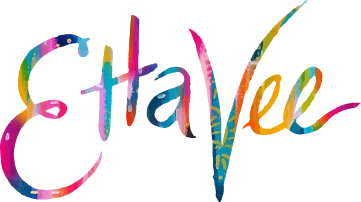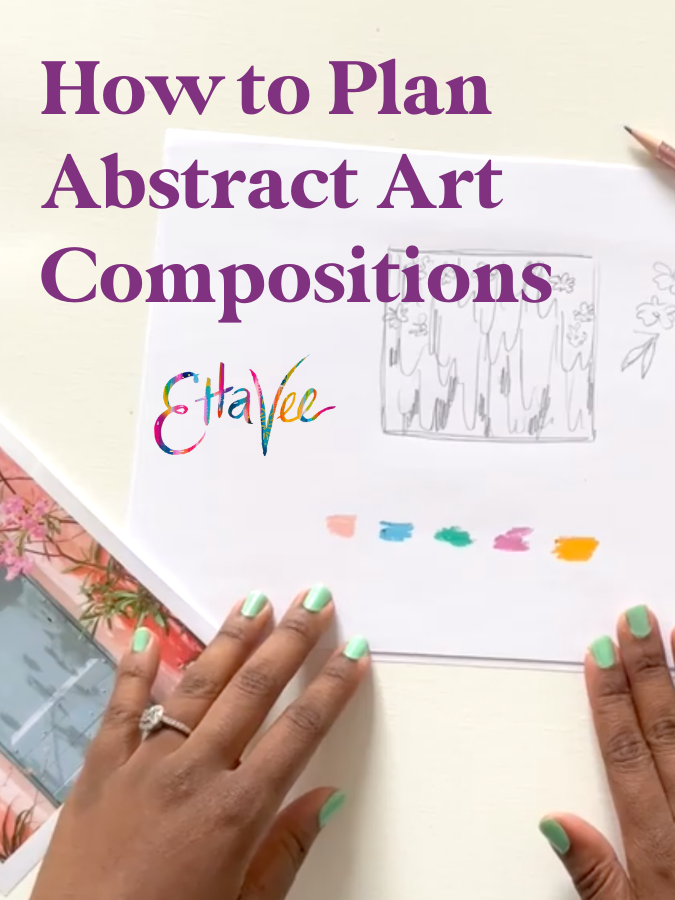How to Plan Abstract Art Compositions
There is a common misconception that abstract paintings are comprised of random brushstrokes thrown together on a canvas, but successful abstract art is actually quite structured. In this post, I’ll share how to plan your abstract compositions so that you can loosen up and paint intuitively knowing that you have a plan.
I’m a big believer in painting intuitively, so planning an abstract composition doesn’t mean that you’ll follow your sketch to the letter. I like to sketch out my compositions so that I have an idea of the structure that I’ll be following for the painting, but I use it as a guide and paint intuitively within that structure. Composition planning allows you to sketch out loose ideas so that your final painting feels more cohesive and polished.
Gathering Inspiration
The first step to planning an abstract art composition is to gather inspiration. If you’re wondering how to find inspiration for your art, start by checking out this post! Once you have a reference photo (or photos!), you’re ready to start building your composition sketch.
Analyze Your Reference Materials
Now it’s time to get curious. Start asking yourself questions about your reference material. What drew you to this particular reference image? Was it the color? The shapes? The shadow? Figuring out what you’re drawn to in your reference will help guide your composition.
In this post, I’m going to use this reference image for building my composition. I love the color palette, how the flowers frame the door, and the shadows towards the bottom. So I’ll use that to build my abstract composition.
Sketch the Composition
Start your sketch by drawing a loose outline of the shape of your canvas.
Now there are a few different things to consider as you’re building your sketch. Let’s go through them one by one!
Shape
Abstract painting is all about shapes. The shapes we paint are the foundation of the piece. Details make it pop, but the heart of an abstract painting is in the shapes. In my pieces, I tend to use my signature brush strokes in V shapes across the canvas. This “V” is also reflected in how the flowers frame the door in my reference photo. I know that that’s what I want to do for this piece, so I’ll start my sketch with that in mind.
The beauty of abstract art is that there are endless options for how to create a piece. Think about what shapes you’re drawn to and what shapes you’re seeing in your reference image. When you’ve decided on the main shapes you’ll be using in the piece, it’s time to play with movement!
Movement
I believe that having a sense of movement through an abstract piece gives it so much interest. I consider movement to be a vital part of all of my abstract compositions. Now that you have the main shapes that you want to use in your piece, consider how you want them to move across the canvas and start to loosely sketch them out.
I want the movement of my painting to feel free and expressive, so I’m placing my V shapes throughout the painting like this:
Motif & Details
Now that you have the main shapes laid down on your sketch, try exploring what it might be like to add some detail elements to your painting. I really love the flowers and branches from my reference photo, so I’m going to very loosely sketch those out next to my canvas composition just to see how I like them.
This is a very experimental part of the sketch. You don’t need to do this if you don’t have details like this in your reference photo, but it can be helpful to take some time to explore different details and shapes to see if there is anything that you want to include in your composition.
Contrast
Next up, I like to sketch out any contrasting areas in my composition. Contrast is an important part of abstract painting because it helps the painting feel more balanced. I like to add contrast to my paintings in both color and shape.
To achieve contrast in shape, I lay down large wash areas of color that follow the shape of my composition. As I build up the layers, I follow the overall shape of the composition but use brushstrokes in varying sizes to provide contrast and visual interest.
When it comes to color contrast, I love to use darker colors towards the bottoms of my paintings. I think this helps weigh them down so that the composition feels more grounded. I like to sketch the darker areas in my initial composition sketch so I can see how that contrast plays out in the composition. In this example, I’m loving the shadows at the bottom of my reference photo, so I’m using those as a guide for placing the darker areas in my sketch.
Color
Lastly, you can sketch out the color palette that you want to use for your painting. Use your reference photo as a guide! In my example, I used the colors from the photo but added a pop of orange that I thought helped complete the palette. You can play with adding color to your sketch to see what you like, but I tend to do that process intuitively while I’m painting. It just comes down to personal preference. Either way, having the color palette sketched out ahead of time will help you as you start to paint your abstract piece!
I hope that this tutorial has helped you with your abstract painting compositions. I know that it can feel a little intimidating to start an abstract painting, but having a composition sketched out ahead of time will help give you the confidence to get started!
And remember, you don’t have to follow it exactly. This is just a guide to give you some structure and to help you get started. Once you start painting, you’re free to follow it as much or as little as you’d like! Experimenting and playing while I’m painting is what I love the most about creating art. Follow the structure, but don’t be afraid to let it flow.
xo, Jessi
If you want to learn more about my abstract painting process including brushstroke techniques, color mixing, layering, and more - join me in my class, Joyful Abstracts!
In this class, I walk you through my abstract painting process step by step. You’ll leave the class with a gorgeous joyful abstract painting, and a whole bunch of new painting skills! I’d love to see you inside!
Pin this post for later! 📌
Hover or tap on this image and click the “Save” button on the top left!








